Abstract
Increasing and improving the critical transition temperature (TC), current density (JC) and the Meissner effect (HC) of conventional superconductors are the most important problems in superconductivity research, but progress has been slow for many years. In this study, by introducing the p-n junction nanostructured electroluminescent inhomogeneous phase with a red wavelength to realize energy injection, we found the improved property of smart meta-superconductors MgB2, the critical transition temperature TC increases by 0.8 K, the current density JC increases by 37%, and the diamagnetism of the Meissner effect HC also significantly improved, compared with pure MgB2. Compared with the previous yttrium oxide inhomogeneous phase, the p-n junction has a higher luminescence intensity, a longer stable life and simpler external field requirements. The coupling between superconducting electrons and surface plasmon polaritons may be explained by this phenomenon. The realization of smart meta-superconductor by the electroluminescent inhomogeneous phase provides a new way to improve the performance of superconductors.
1. Introduction
Superconductivity has greatly promoted the progress of industrial technology since its discovery, and has also expanded people’s understanding of condensed matter physics [1]. The superconducting materials have a wide range of applications, such as electric grids [2], and quantum computing devices [3,4]. The pursuit of superconducting materials with a high critical temperature TC has been promoting the research. The high-temperature superconductor [5,6], iron-based superconductor [7,8], high-pressure superconductor [9,10,11,12] and photoinduced superconductor [13,14] have been gradually studied and discovered. Superconductors have zero resistance characteristics and complete diamagnetism (the Meissner effect) [15,16,17]. Therefore, the transition from a superconducting state to a non-superconducting state has characteristic parameters: critical transition temperature (TC), critical current density (JC) and critical magnetic field (HC) [15,18]. In recent years, it has been found that the superconductivity of the sulfur hydride system is 203 K at 155 GPa [9], and the carbonized sulfur hydride system is 287.7 K at 267 GPa [12]. Although this method can achieve higher superconducting transition temperatures and even room temperature superconductivity, the extremely high pressure and small sample size limit its further applications.
The discovery of the MgB2 superconductor [19] has aroused great interest in the scientific community due to its excellent superconductivity and simple preparation process, especially its high TC. In order to improve the superconductivity of MgB2, various methods have been adopted [20,21,22,23,24], which can not only improve the practical application of MgB2, but also further clarify its superconductivity mechanism. Chemical doping is often used to study superconductivity. Unfortunately, many experimental results have confirmed that this approach reduces the TC of MgB2 [25,26,27,28]. So far, there is no effective strategy to improve the TC of MgB2. Chemical doping is the simplest method to change the JC of the superconductor. Doping graphene in MgB2 [29], and Al2O3 [30] and MgO [31] in BiSrCaCuO will reduce JC under a zero magnetic field. At the same time, adding anthracene into MgB2 [32] and Cr2O3 into BiSrCaCuO [33] will increase the JC under a zero magnetic field. Under a zero magnetic field, chemical doping increases or decreases JC of the superconductor, but correspondingly decreases TC. There is no particularly effective method to increase TC and JC at the same time.
Metamaterials with artificial structures have supernormal physical properties [34,35]. With the development of metamaterials, researchers proposed that a metamaterial superconductor can exhibit a higher TC [36,37,38]. In 2007, we proposed to introduce inorganic ZnO electroluminescent (EL) material into a Bi(Pb)SrCaCuO superconductor at a high temperature in order to affect its superconducting transition temperature [39,40]. In recent years, MgB2 and Bi(Pb)SrCaCuO smart meta-superconductors (SMSCs) have been constructed. We doped Y2O3:Eu3+ and Y2O3:Eu3++Ag EL materials in conventional MgB2 and high temperature Bi(Pb)SrCaCuO superconductors to form a smart meta-superconductor [39,40,41,42,43,44,45,46,47]. When the TC of SMSCs is measured by the four-probe method, the external electric field can stimulate the inhomogeneous phase to produce EL, which can achieve the purpose of strengthening the Cooper pair and lead to the macroscopic change of TC. SMSCs is a material that can adjust and improve TC through external field stimulation, which is a new property that cannot be achieved by traditional second phase doping [44,45,46]. We believe that this is because superconducting particles acting as microelectrodes excite the inhomogeneous phase EL under the action of an applied electric field, and the energy injection promotes the formation of electron pairs. Recently, JC and the Meissner effects of the MgB2 and Bi(Pb)SrCaCuO smart meta-superconductors have been investigated [47]. The addition of Y2O3:Eu3+ and Y2O3:Eu3++Ag increased the JC of MgB2 and Bi(Pb)SrCaCuO, and indicating the Meissner effect at higher temperatures. It has been confirmed that the rare earth oxide inhomogeneous phase can improve the TC, JC, and Meissner effect of conventional and high temperature oxide superconductors. However, it is very difficult to improve the electroluminescence intensity, short luminescence life, large applied electric field and other factors of rare earth oxides, which limits the improvement of its superconducting performance.
In this paper, the smart superconductivity of MgB2 was studied by introducing the p-n junction electroluminescence inhomogeneous phase to realize energy injection and improve electron pairing. Studies show that the high luminescence intensity and long life of the p-n junction nanostructure can ensure the stability of material properties. In addition, the p-n junction nanostructure excitation is easier, with only a few volts of excitation required rather than hundreds or even thousands of volts. Thus, the electric field applied by the four-point method for measuring superconductivity can be satisfied. Because the p-n junction nanostructured inhomogeneous phase exhibits good behavior under field excitation, the optimum amount of the inhomogeneous phase increased from 0.5wt.% to 1.0wt.% compared to oxide. Therefore, the critical temperature TC, current density JC and the Meissner effect of superconducting transition are higher than those of the oxide inhomogeneous phase. In particular, the performance stability of the material has been greatly improved, and can be stable for more than several hundred hours. We hold the opinion that the photons generated by the inhomogeneous phase of the p-n junction nanostructure interact with some superconducting electrons to generate surface plasmon polaritons (SPPs) and promote electron pair transport.
2. Model
Figure 1 shows the MgB2 SMSCs model constructed with polycrystalline MgB2 as raw material. The gray polyhedrons are polycrystalline MgB2 particles, Φ is the particle size of MgB2 particle, which will be described in detail in the experimental part. The red particles are p-n junction particles with red light wavelengths, which are dispersed among MgB2 particles as the inhomogeneous phase. The introduction of the inhomogeneous phase inevitably reduces the TC of MgB2, mainly because the doped inhomogeneous phase is not a superconductor, which is detrimental to the superconductivity of MgB2, such as the MgO impurity phase in MgB2. For convenience, the reduction of TC after the introduction of the inhomogeneous phases is called the impurity effect [39,40,41]. The incorporation of inhomogeneous phases has been proved to be an effective method to improve TC in MgB2 and Bi(Pb)SrCaCuO systems. For example, the introduction of electroluminescence Y2O3:Eu3+ and Y2O3:Eu3++Ag can produce an electroluminescence effect and increase TC [42,43,44,45,46]. There is obvious competition between the impurity effect and the EL excitation effect of the inhomogeneous phase. When the EL excitation effect is dominant, TC is improved (ΔTc > 0). Otherwise, the inhomogeneous phase is introduced to reduce TC (ΔTc < 0). Therefore, the impurity effect should be reduced as much as possible and the EL excitation effect should be enhanced in order to obtain high TC samples. The superconductivity of a smart meta-superconductor can be improved and adjusted by adding the EL inhomogeneous phase [45,46]. It has been known that variations in TC are often related to variations in electron density [48,49]. However, under the current preparation conditions, the inhomogeneous phase only exists between MgB2 particles and does not react with MgB2. Moreover, the diffusion between the inhomogeneous phase and MgB2 particles is difficult, and the electron density cannot be significantly changed. Therefore, electron density is not a key tuning parameter affecting TC variation. During the measurement process, the applied electric field forms a local electric field in the superconductor and excites the inhomogeneous phase to generate EL excited photon injection energy, which is beneficial to the enhancement of the Cooper pair and the change of TC. However, given that photons may destroy the Cooper pair, the mechanism for the occurrence of TC changes needs to be further explored. Later, according to the experimental results, we will explain this phenomenon by the inhomogeneous phase EL.
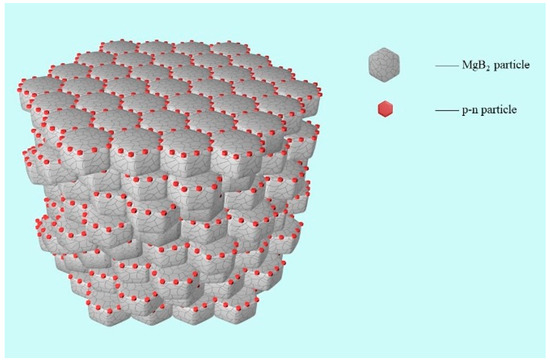
Figure 1.
MgB2 SMSCs model diagram.
3. Experiment
3.1. Preparation of p-n Junction Luminescent Particles
We purchased commercial red LED epitaxial chip, its luminous composition is the AlGaInP composite structure, and luminous wavelength is 623 nm. The compound AlGaInP is produced by Shandong Huaguang Optoelectronics Co., Ltd., Jinan, China. It uses trimethylgallium, trimethylindium, trimethylaluminum and phosphorane as raw materials and as reactants, which are brought into the vacuum furnace by hydrogen for reaction growth on the substrate. The melting point of the product AlGaInP is between 1200 and 1400 °C. We stripped compounds off the substrate, ground them to obtain particles of about 4 µm × 4 µm × 1.7 µm. The particles consisted of three-layer nanostructures: a p-type semiconductor layer (250 nm thick), an active layer (250 nm thick), and an n-type semiconductor layer (1200 nm thick). The electroluminescence test method is the same as that of rare earth luminescent particles, and the measurement conditions were given in the text. The applied voltage <10 V, current <10 mA, test luminescence curve is shown in Figure 2. The luminescence curves of the electroluminescent rare earth oxide particles in the figure were obtained from the samples prepared by our group [50,51]. It can be seen that the luminescence intensity of the p-n junction particles is much higher than that of electroluminescent rare earth oxide particles. After more than 2000 h of work, the luminescence intensity almost did not decay, and the luminescence behavior did not change after 100 days. The characteristics of high strength and long life of the p-n junction provided a solid foundation for improving smart meta-superconductors.
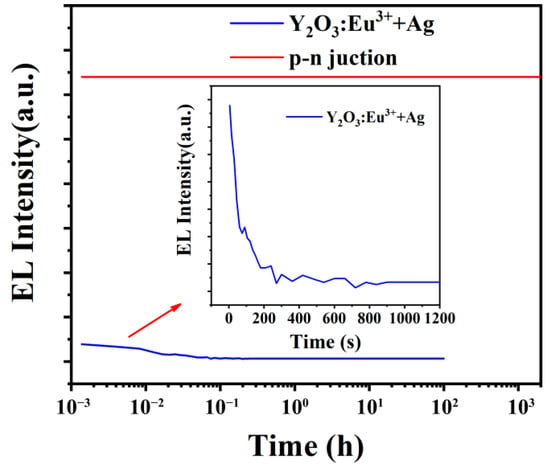
Figure 2.
Luminescence intensity and lifetime test curves of p-n junction particles and rare earth oxide particles in red light wavelengths.
3.2. Preparation of MgB2 Superconductor and Inhomogeneous Phase Samples
Magnesium diboride (MgB2) was purchased from Alfa Aesar with a purity of 99% and a particle size of 100 mesh (150 µm). A certain amount of MgB2 basic powder raw material was put into a 500 mesh (30 µm) stainless steel standard sieve, and the large sized particles were removed by screening to get the basic uniform size of MgB2 particles, with a diameter of Φ ≤ 30 μm. Figure 3a,b show the SEM image of MgB2 and the p-n junction particles. Figure 3c show the XRD test curves of pure MgB2, AlGaInP and MgB2+ 1.2 wt.% AlGaInP samples. Figure 3d is a partial enlarged drawing of Figure 3c, where the vertical dotted line corresponds to the diffraction peak of AlGaInP. The comparison results show that in addition to the MgB2 phase, there is an independent AlGaInP phase in the doped sample, indicating that there is no chemical reaction between the two. A certain amount of MgB2 powder raw materials and corresponding inhomogeneous phase p-n particles with different mass fractions were weighed and put into two beakers, respectively, to make an alcohol solution and then ultrasonic was used for 20 min. The two solutions were placed on a magnetic stirrer for stirring, and the inhomogeneous phase solution was added to the MgB2 solution drop by drop during stirring. After the dripping, the mixed solution was stirred for 10 min and ultrasonic was used for 20 min. Then, it was transferred to petri dishes and dried in a vacuum drying oven at 60 °C for 4 h to obtain a black powder. The powder was fully ground and pressed into a wafer with a diameter of 11 mm and a thickness of 1.2 mm. The pressure and holding time were 14 MPa and 10 min, respectively. The wafer was then placed in a small box made of tantalum, and the box was then placed in an alumina porcelain boat, which was finally transferred to a vacuum tube furnace. In the high pure Ar atmosphere, the samples were slowly heated to 840 °C in the vacuum tube furnace for 10 min, then cooled to a 650 °C temperature calcination for 1h, and then slowly cooled to room temperature to obtain the corresponding samples [43,46]. Pure MgB2 samples (represented by S0) and the p-n junction doped MgB2 samples were prepared, with the concentration of dopant corresponding to each sample as shown in Table 1. In the experiment, the influence of the inhomogeneous phase of luminescence on the superconducting transition temperature of the MgB2-based superconductor was studied by changing the content of the inhomogeneous phase.
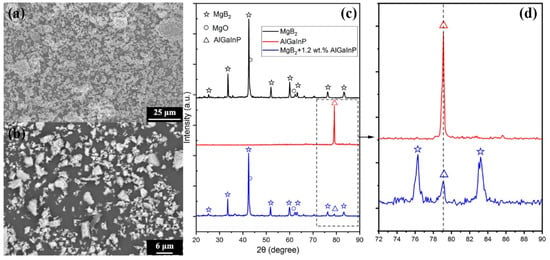
Figure 3.
SEM diagram of (a) MgB2 particles, diameter Φ ≤ 30 μm, (b) p-n junction particles, ground into 4 μm × 4 μm × 1.7 μm particles, (c) the XRD test curves of pure MgB2, AlGaInP and MgB2 + 1.2 wt.% AlGaInP samples, (d) a partial enlarged drawing of (c).

Table 1.
MgB2 doped inhoumgenous phase with different concentrations.
Figure 4a shows the SEM image of the MgB2 + 0.9 wt.% p-n junction after sintering. Figure 4b–d show the EDS mapping for elements Mg, Al, and Ga listed in the top right corner of each figure. The distribution of elements in Figure 4 shows the discrete distribution of the Al and Ga elements and the aggregation distribution of the AlGaInP inhomogeneous phase. Due to the uneven size and distribution of the AlGaInP particles, as well as the distribution of Al and Ga elements in the particles during the p-n junction, preparation by vapor deposition may lead to the change of their positions and concentrations.
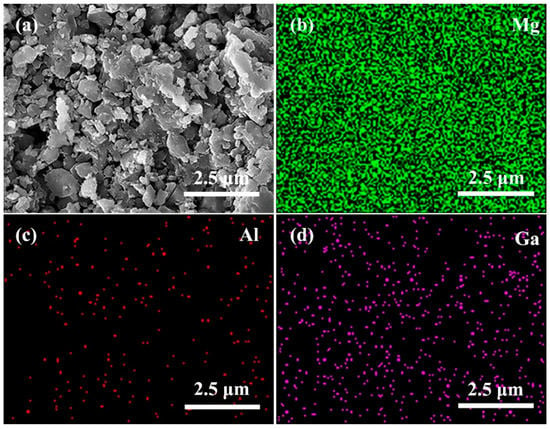
Figure 4.
(a) SEM diagram of sample after sintering, (b–d) EDS mapping of Mg, Al, Ga.
3.3. Critical Transition Temperature Measurement
A four-lead method was used to measure the R-T curve of the sample at a low temperature, with a distance of 1 mm between the four probes to determine the superconducting transition temperature TC of the sample. The closed-cycle cryostat manufactured by Advanced Research Systems provides a low temperature environment (the minimum temperature is 10 K); the test current (1–100 mA) is provided by the high temperature superconducting material characteristic test device, produced by the Shanghai Qianfeng Electronic Instrument Co., Ltd., Shanghai, China, Voltages were measured using a Keithley nanovolt meter; we adjusted the test temperature with a Lake Shore cryogenic temperature controller. The whole testing process was carried out in a vacuum environment [41,46].
3.4. Measurement of Critical Current Density and Meissner Effect
The sample was placed in a low-temperature medium and the current-voltage (I-V) characteristic curve was measured by a four-probe method under a zero magnetic field. A certain amount of direct current was connected to the prepared sample by two leads, and the other two leads were used to measure the voltage of the prepared sample by a Keithley digital nanovoltmeter. We used indium wire to connect the sample to the lead, and the distance between the two voltage leads for all samples is 1 mm. When the current I passing through the sample exceeds a certain value, the superconducting state is destroyed and changes to the normal state. This current is called the critical transport current of the superconductor. Typically in superconducting systems, the transport critical current density (JC) is determined by I-V measurements at different temperatures (below the initial transition temperature TC,on), with a voltage criterion of 1 μV/cm [47,52,53,54]. The shape and size of all samples and the distance between the current and voltage leads were kept the same during the test. Subsequently, the prepared samples were tested for DC magnetization [47,55]. The samples were cooled slowly in a magnetic field of 1.8 mT parallel to the plane, and data were collected during heating. All samples showed complete diamagnetism.
4. Results and Discussion
Figure 5 is the normalized resistivity curve of the doped x wt.% luminescent inhomogeneous phase p-n junction (x = 0, 0.5, 0.8, 0.9, 1.0, 1.2, 1.5) prepared with MgB2 raw material. x is the doping concentration, where x = 0 is the pure sample MgB2. The black curve in Figure 5a is the normalized R-T curve of the pure MgB2 sample, and the results show that the TC of the pure MgB2 sample is 37.4–38.2 K. The other six curves correspond to the R-T curve of MgB2 sample doped with the p-n junction, and the results show that the TC corresponding to these six doped samples are 36.8–38 K, 37.4–38.4 K, 37.6–39 K, 37.8–38.8 K, 38–38.7 K and 37.2–38.4 K, respectively. The test results show that at low dopant concentrations, such as 0.5 wt.%, the inhomogeneous phases reduce the TC of the MgB2 samples (∆TC < 0) [56,57]. However, when the dopant concentration reaches a certain value, such as 0.8 wt.%, the inhomogeneous phase enhancement effect occurs, and TC exceeds the pure sample (∆TC >0). When the dopant concentration is 0.9 wt.%, ∆T reaches an increased maximum value of 0.8 K and continues to increase the content of the inhomogeneous phase, while ∆T decreases instead. The characteristics are the same as those of the previous oxide inhomogeneous phase doping results [43,46].

Figure 5.
R-T curve of MgB2 sample. (a) Doping results of pure MgB2 and inhomogeneous phase at different concentrations, Insets: the values of ΔTC (ΔTc = Tc − Tcpure). (b) Comparison of the maximum variation of ∆TC produced by pure MgB2 and oxide electroluminescence inhomogeneous phase [46], p-n junction inhomogeneous phase.
Figure 6 shows the relationship between JC and the temperature of the pure MgB2 and p-n junction with different doping concentrations, which is determined by I-V measurement. It can be seen from Figure 6a that JC of pure MgB2 and the doped samples decreases with the increase of temperature, which is consistent with the results in literature [34,58,59]. JC of pure MgB2 is 8.5 × 104 A/cm2 at 20 K, which is comparable to literature [60,61]. At this time, the JC of the 0.9 wt.% luminescent inhomogeneous phase doped sample is 8.83 × 104 A/cm2. When the temperature is low, JC decreases slowly, and with the increase of temperature, the speed accelerates. The doping of the electroluminescence inhomogeneous phase increases JC, when T = 36 K, JC of samples with doping concentration of 0.9 wt.% is 37% higher than that of pure MgB2. When the inhomogeneous phase concentration is 0.5 wt.%, JC of the sample decreases to a minimum value faster than pure MgB2; and the samples with higher inhomogeneous phase concentration can have JC at a higher temperature. For example, JC of pure MgB2 was reduced to a minimum at 38.2 K, JC of the 0.9 wt.% doped sample was reduced to a minimum at 39 K, and JC of the 1.2 wt % doped sample was reduced to a minimum at 38.7 K.
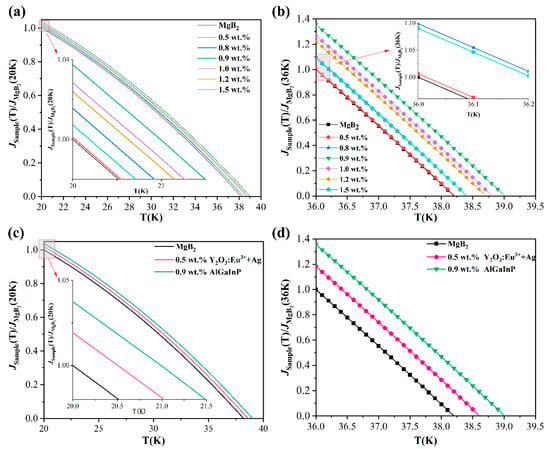
Figure 6.
Relationship between JC and temperature T of MgB2 samples. (a,b) Pure MgB2 and inhomogeneous phase samples. (c,d) Comparison of JC for the maximum variation of TC produced by pure MgB2 and oxide luminescent inhomogeneous phase [46], p-n junction inhomogeneous phase.
Figure 7 shows the DC magnetization data of pure MgB2 and MgB2 mixed with the inhomogeneous phase. The vertical axis shows the complete diamagnetism change of the material, and the Meissner effect of all samples can be observed through the DC magnetization data. With the increase of temperature, complete diamagnetism, or the Meissner effect weakens and eventually disappears, which is consistent with literature [62,63,64]. The Meissner effect of pure MgB2 samples disappeared at 37.4 K, and that of the 0.5 wt.% inhomogeneous phase MgB2 samples disappeared at 36.8 K. The Meissner effect of 0.9 wt.%, 1.0 wt.% and 1.2 wt.% MgB2 samples disappeared when the temperature was higher than 37.6 K, 37.8 K and 38 K, respectively. It can be seen that the diamagnetic property of the inhomogeneous phase samples with higher concentration is greatly improved compared with that of pure MgB2. For example, the Meissner effect of the 0.9 wt.% and 1.2 wt.% of the inhomogeneous phase doped MgB2 samples was increased, compared with that of pure MgB2. The superconductivity of MgB2 doped with 1.5 wt.%, 0.9 wt.%, 1.0 wt.%, 1.2 wt.% AlGaInP were similar. Because the superconductivity of samples with the concentrations of 1.5 wt.% and 0.8 wt.% are very close, they are not marked here.
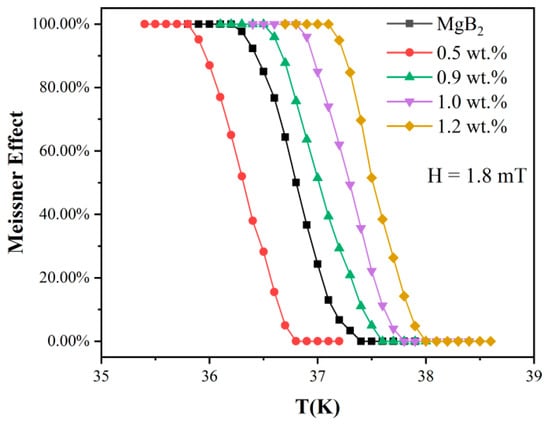
Figure 7.
DC magnetization data of pure MgB2 and MgB2 doped with inhomogeneous phase.
It can be seen that the p-n junction inhomogeneous phase can produce exactly the same effect as the rare earth oxide inhomogeneous phase. Figure 5b critical transition temperature and Figure 6c,d critical current intensity indicate that the p-n junction inhomogeneous phase’s behavior is further improved compared with that of the rare earth oxide inhomogeneous phase. The main reasons may be:
- (1)
- The advantages of the inhomogeneous phase of the p-n junction nanostructure
Compared with the previous yttrium oxide inhomogeneous phase, the luminescence intensity and long life of the p-n junction nanostructure are far more than those of the previous electro-induced rare earth luminescence materials (Figure 2), which can ensure the stability of material properties. In addition, the p-n junction nanostructure excitation is easier, with only a few volts of excitation required, not hundreds or even thousands of volts. Thus, the electric field applied by the four-point method for measuring superconductivity can meet the requirement. Recently, the mechanism for increasing TC has been further explored. Figure 8 shows the Raman spectra for pure MgB2 and MgB2 doped with 0.5 wt.% Y2O3, 1.2 wt.% AlGaInP, 1.0 wt.% AlGaInP, and 0.9 wt.% AlGaInP. Y2O3 is a control dopant with no electroluminescent effect. The black scattered points are the measured data, which can be fitted by the Gaussian equation [65] and the results are shown as the red solid lines. Figure 8a show that the Raman shift (ω) of the main peak in the Raman spectrum of pure MgB2 is 579.2 cm−1, which corresponds to the E2g phonon mode in MgB2, and the linewidth (γ) is 199.1 cm−1. The measurements are consistent with the results reported in other literature [66,67,68,69]. After doping with 0.5 wt.% Y2O3, the ω and γ of the E2g phonon mode are 583.7 cm−1 and 175.4 cm−1 as shown in Figure 8b. The results show that the doping of Y2O3 leads to the hardening of the E2g phonon mode [70,71,72], which weakens the electron-phonon coupling in the MgB2 and decreases the TC to 37.6 K. In contrast, the doping of AlGaInP leads to a decrease of ω and an increase of γ. Such a phenomenon of softening of the E2g phonon mode indicates an enhancement of the electron-phonon coupling in the sample [66,73,74], which is beneficial to the improvement of TC. The ω(γ) for MgB2 doped with 1.2 wt.%, 1.0 wt.%, and 0.9 wt.% AlGaInP are 557.3 cm−1 (234.1 cm−1), 554.6 cm−1 (236.5 cm−1), and 552.4 cm−1 (245.2 cm−1), and the corresponding TC are 38.7 K, 38.8 K, and 39.0 K. TC increases with the enhancement of the softening effect. These results suggest that the softening of the E2g phonon mode in MgB2 doped with AlGaInP may be the main reason for the enhancement of TC. Meanwhile, there are still some problems to be solved, such as how to obtain AlGaInP with a uniform particle size and how to distribute the AlGaInP particles evenly in the sample. We will do further research on these issues and study the mechanism in more detail in the follow-up work.
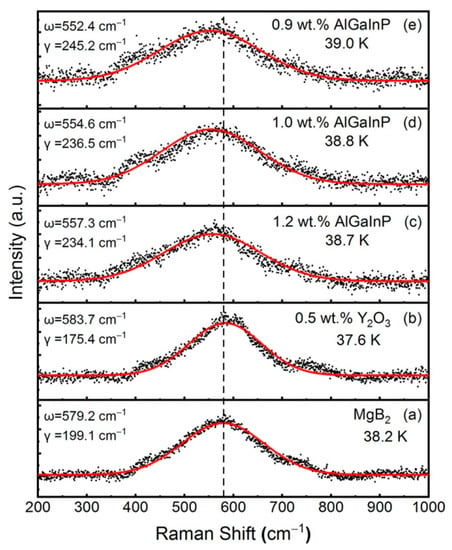
Figure 8.
Raman spectra of (a) pure MgB2 and MgB2 doped with (b) 0.5 wt.% Y2O3, (c) 1.2 wt.% AlGaInP, (d) 1.0 wt.% AlGaInP, and (e) 0.9 wt.% AlGaInP.
- (2)
- Performance improvement of smart meta-superconductor
Because the p-n junction inhomogeneous phase exhibits good behavior under external field excitation, the optimal amount of the dopable inhomogeneous phase increases from 0.5 wt.% to 1 wt.% compared with oxide. Thus, the critical temperature TC, current density JC and the Meissner effect of superconductor can be improved compared with the oxide inhomogeneous phase, which provides a wider range for the adjustment of material properties. In particular, the performance stability of the material has been greatly improved, and can be stable for more than several hundred hours. The doping of AlGaInP with too large or too small particle sizes even decreased the TC of MgB2. Therefore, selecting AlGaInP with a suitable particle size is also an important factor to improve the TC. However, AlGaInP particles with a uniform size cannot be obtained by the current preparing process. Improving the preparation process to obtain AlGaInP particles with a uniform size is a focus in our follow-up work.
- (3)
- The origin of smart superconductivity
In order to explain the above experimental results, we propose an explanatory view of smart superconductivity. Figure 9 shows the schematic diagram of smart superconductivity. By introducing the p-n junction electroluminescent inhomogeneous phase, the photon generated by the inhomogeneous phase in the external field interacts with some superconducting electrons to produce surface plasmon polaritons. The generated evanescent wave can transmit a large number of superconducting electrons with the same energy unimpeded, resulting in the surface plasma system to promote the intense interaction of electrons. The energy injection improves the electron pairing state, promote the superconductivity behavior of the material, increases the critical transition temperature, and forms smart superconductivity.
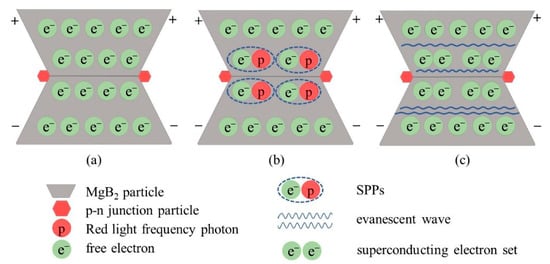
Figure 9.
Schematic diagram of smart superconductivity generation. (a) Free electrons are uniformly distributed in the superconductor before the measurement field is applied. (b) After the measurement electric field is applied, the p-n junction particles in red light wavelength glow and generate a large number of photons. The interaction between photons and some conduction electrons occurs at the particle interface, forming plasmons. (c) These surface plasmons propagate as evanescent waves and can transport superconducting electrons. Due to the unimpeded transmission of evanescent wave, the superconductivity of system electrons at higher temperature is promoted.
The conventional superconductor MgB2 is a standard electroacoustic interaction to form a superconducting transition. It can be seen that before reaching the critical temperature TC, the current density JC (Figure 6) and the diamagnetism HC corresponding to the Meissner effect (Figure 7) of the smart meta-superconductor MgB2 are both higher than that of pure MgB2, it is due to the superposition of the electro-acoustic interaction and the SPPs interaction with superconducting electrons. In the experiment, we used two methods of heating and cooling to test. In the heating method, the temperature of the system is reduced to about 10 K first, and then the heating begins. When the temperature exceeds the critical transition temperature of the pure sample, the electro-acoustic interaction fails, but the interaction between the surface plasmas of the smart meta-superconductor and the superconducting electron still exists. Therefore, the critical transition temperature of the smart meta-superconductor MgB2 is higher than that of the pure MgB2 superconductor (Figure 5). In the state where JC of the pure MgB2 superconductor is zero and diamagnetism disappears, JC of the smart meta-superconductor MgB2 is still non-zero (Figure 6b,d) and diamagnetism still exists (Figure 7). In the cooling method, the system drops from room temperature to 39.1 K, and the initial transition occurs as the temperature continues to drop. The temperature has not reached the critical transition temperature of pure samples of 38.2 K, and the electro-acoustic effect has not yet taken place, but the superconducting transition phenomenon appears, and JC of the smart meta-superconductor MgB2 also appears. These phenomena confirm that electron-plasmon coupling has been formed, superconducting phase transition has occurred, and smart superconductivity has been achieved. It should be noted that, due to the presence of material resistance, when the temperature reaches a certain point, the interaction between the surface plasmas and the superconducting electrons cannot counteract the effect of material resistance, and superconductivity disappears. However, it is possible to raise the critical transition temperature further by improving the ability of the inhomogeneous phase. Since evanescent waves can exist and transmit at relatively high temperatures, the coupling of superconducting electrons with surface plasmons may promote smart superconductivity at higher temperatures.
Here, we find that the conventional superconductor MgB2 exhibits smart superconductivity. In fact, in previous studies, we have studied the high-temperature oxide superconductor, and the smart meta-superconductor can also be formed by doping the rare earth oxide inhomogeneous phase [44,45,47]. Therefore, it can be concluded that they can also show smart superconductivity by the p-n junction nanostructured inhomogeneous phase, and we will provide the research results in the future.
5. Conclusions
In this study, by introducing the p-n junction nanostructured electroluminescent inhomogeneous phase with red wavelength to realize energy injection, the critical transition temperature TC, the current density JC and the diamagnetism of the Meissner effect HC of the smart meta-superconductor MgB2 are studied. The conclusions are as follows:
(1) The smart meta-superconductor compared with pure MgB2, the critical transition temperature TC is increased by 0.8 K, the current density JC is increased by 37%, and the diamagnetism of the Meissner effect HC are also significantly improved.
(2) The p-n junction nanostructured inhomogeneous phase has high luminescence intensity, a long stable life and simpler external field requirements. This p-n junction nanostructured inhomogeneous phase SMSCs produces more significant performance changes than the previous yttrium oxide inhomogeneous phase. Under the same conditions, the critical transition temperature ∆T increases by nearly 1 time, and the current density JC increases significantly.
The coupling between superconducting electrons and SPPs is regarded as an explanation for this phenomenon. The smart meta-superconductor generated by the inhomogeneous phase opens up a new way to improve the performance of superconductors.
Author Contributions
Conceptualization, methodology, X.Z.; software, Q.H., M.S. and H.C.; validation, X.Z., Q.H., M.S. and H.C.; formal analysis, X.Z., H.C. and Y.L.; investigation, Q.H., M.S., H.C., Y.L. and Y.Q.; resources, X.Z.; data curation, H.C., Y.L. and Y.Q., writing—original draft preparation, X.Z.; writing—review and editing, X.Z. and H.C.; visualization, X.Z., Q.H. and M.S.; supervision, X.Z.; project administration, X.Z.; funding acquisition, X.Z. All authors have read and agreed to the published version of the manuscript.
Funding
This research was supported by the National Natural Science Foundation of China for Distinguished Young Scholar under Grant No. 50025207.
Institutional Review Board Statement
Not applicable.
Informed Consent Statement
Not applicable.
Data Availability Statement
The data presented in this study are available on reasonable request from the corresponding author.
Conflicts of Interest
The authors declare no conflict of interest.
References
- Gui, X.; Lv, B.; Xie, W.W. Chemistry in Superconductors. Chem. Rev. 2021, 121, 2966–2991. [Google Scholar] [CrossRef]
- Fossheim, K.; Sudbø, A. What Is Superconductivity? A Brief Overview. In Superconductivity: Physics and Applications; John Wiley & Sons Ltd.: Chichester, UK, 2004; pp. 1–26. [Google Scholar] [CrossRef]
- DiCarlo, L.; Reed, M.D.; Sun, L.; Johnson, B.R.; Chow, J.M.; Gambetta, J.M.; Frunzio, L.; Girvin, S.M.; Devoret, M.H.; Schoelkopf, R.J. Preparation and Measurement of Three-Qubit Entanglement in a Superconducting Circuit. Nature 2010, 467, 574–578. [Google Scholar] [CrossRef] [PubMed]
- Riedinger, R.; Wallucks, A.; Marinković, I.; Löschnauer, C.; Aspelmeyer, M.; Hong, S.; Gröblacher, S. Remote Quantum Entanglement between Two Micromechanical Oscillators. Nature 2018, 556, 473–477. [Google Scholar] [CrossRef] [PubMed]
- Bednorz, J.G.; Müller, K.A. Possible high TC superconductivity in the Ba-La-Cu-O system. Z. Phys. B Condens. Matter 1986, 64, 189–193. [Google Scholar] [CrossRef]
- Mohd Yusuf, N.; Awang Kechik, M.; Baqiah, H.; Soo Kien, C.; Kean Pah, L.; Shaari, A.; Wan Jusoh, W.; Abd Sukor, S.; Mousa Dihom, M.; Talib, Z.; et al. Structural and Superconducting Properties of Thermal Treatment-Synthesised Bulk YBa2Cu3O7-δ Superconductor: Effect of Addition of SnO2 Nanoparticles. Materials 2018, 12, 92. [Google Scholar] [CrossRef] [PubMed]
- Kamihara, Y.; Watanabe, T.; Hirano, M.; Hosono, H. Iron-Based Layered Superconductor La[O1-XFX]FeAs (x = 0.05–0.12) with TC = 26 K. J. Am. Chem. Soc. 2008, 130, 3296–3297. [Google Scholar] [CrossRef]
- Zhang, P.; Yaji, K.; Hashimoto, T.; Ota, Y.; Kondo, T.; Okazaki, K.; Wang, Z.; Wen, J.; Gu, G.D.; Ding, H.; et al. Observation of topological superconductivity on the surface of an iron-based superconductor. Science 2018, 360, 182–186. [Google Scholar] [CrossRef] [PubMed]
- Drozdov, A.P.; Eremets, M.I.; Troyan, I.A.; Ksenofontov, V.; Shylin, S.I. Conventional superconductivity at 203 kelvin at high pressures in the sulfur hydride system. Nature 2015, 525, 73–76. [Google Scholar] [CrossRef]
- Cantaluppi, A.; Buzzi, M.; Jotzu, G.; Nicoletti, D.; Mitrano, M.; Pontiroli, D.; Ricco, M.; Perucchi, A.; Di Pietro, P.; Cavalleri, A. Pressure tuning of light-induced superconductivity in K3C60. Nat. Phys. 2018, 14, 837–841. [Google Scholar] [CrossRef]
- Drozdov, A.P.; Kong, P.P.; Minkov, V.S.; Besedin, S.P.; Kuzovnikov, M.A.; Mozaffari, S.; Balicas, L.; Balakirev, F.F.; Graf, D.E.; Prakapenka, V.B.; et al. Superconductivity at 250 K in lanthanum hydride under high pressures. Nature 2019, 569, 528–531. [Google Scholar] [CrossRef]
- Snider, E.; Dasenbrock-Gammon, N.; McBride, R.; Debessai, M.; Vindana, H.; Vencatasamy, K.; Lawler, K.V.; Salamat, A.; Dias, R.P. Room-temperature superconductivity in a carbonaceous sulfur hydride. Nature 2020, 586, 373–377. [Google Scholar] [CrossRef] [PubMed]
- Fausti, D.; Tobey, R.I.; Dean, N.; Kaiser, S.; Dienst, A.; Hoffmann, M.C.; Pyon, S.; Takayama, T.; Takagi, H.; Cavalleri, A. Light-induced superconductivity in a stripe-ordered cuprate. Science 2011, 331, 189–191. [Google Scholar] [CrossRef] [PubMed]
- Cavalleri, A. Photo-induced superconductivity. Contemp. Phys. 2017, 59, 31–46. [Google Scholar] [CrossRef]
- Bardeen, J.; Cooper, L.N.; Schrieffer, J.R. Theory of Superconductivity. Phys. Rev. 1957, 108, 1175–1204. [Google Scholar] [CrossRef]
- Bardeen, J. Theory of the Meissner Effect in Superconductors. Phys. Rev. 1955, 97, 1724–1725. [Google Scholar] [CrossRef]
- Chung, D.Y. The Basic Cause of Superconductivity. J. Mod. Phys. 2015, 6, 26–36. [Google Scholar] [CrossRef][Green Version]
- Qiu, D.; Gong, C.; Wang, S.; Zhang, M.; Yang, C.; Wang, X.; Xiong, J. Recent Advances in 2D Superconductors. Adv. Mater. 2021, 33, e2006124. [Google Scholar] [CrossRef]
- Nagamatsu, J.; Nakagawa, N.; Muranaka, T.; Zenitani, Y.; Akimitsu, J. Superconductivity at 39 K in magnesium diboride. Nature 2001, 410, 63–64. [Google Scholar] [CrossRef]
- Zhao, Y.G.; Zhang, X.P.; Qiao, P.T.; Zhang, H.T.; Jia, S.L.; Cao, B.S.; Zhu, M.H.; Han, Z.H.; Wang, X.L.; Gu, B.L. Effect of Li doping on structure and superconducting transition temperature of Mg1-xLixB2. Phys. C 2001, 361, 91–94. [Google Scholar] [CrossRef]
- Mackinnon, I.D.R.; Winnett, A.; Alarco, J.A.; Talbot, P.C. Synthesis of MgB2 at low temperature and autogenous pressure. Materials 2014, 7, 3901–3918. [Google Scholar] [CrossRef]
- Ozturk, O.; Asikuzun, E.; Kaya, S.; Koc, N.S.; Erdem, M. The effect of Ar ambient pressure and annealing duration on the cicrostructure, superconducting properties and activation energies of MgB2 superconductors. J. Supercond. Nov. Magn. 2016, 30, 1161–1169. [Google Scholar] [CrossRef]
- Cheng, F.; Ma, Z.; Liu, C.; Li, H.; Shahriar, A.; Hossain, M.; Bando, Y.; Yamauchi, Y.; Fatehmulla, A.; Farooq, W.A.; et al. Enhancement of grain connectivity and critical current density in the ex-situ sintered MgB2 superconductors by doping minor Cu. J. Alloys Compd. 2017, 727, 1105–1109. [Google Scholar] [CrossRef]
- Grivel, J.C.; Rubešová, K. Increase of the critical current density of MgB2 superconducting bulk samples by means of methylene blue dye additions. Phys. C 2019, 565, 1353506. [Google Scholar] [CrossRef]
- Slusky, J.S.; Rogado, N.; Regan, K.A.; Hayward, M.A.; Khalifah, P.; He, T.; Inumaru, K.; Loureiro, S.M.; Haas, M.K.; Zandbergen, H.W.; et al. Loss of superconductivity with the addition of Al to MgB2 and a structural transition in Mg1-xAlxB2. Nature 2001, 410, 343. [Google Scholar] [CrossRef]
- Li, S.Y.; Xiong, Y.M.; Mo, W.Q.; Fan, R.; Wang, C.H.; Luo, X.G.; Sun, Z.; Zhang, H.T.; Li, L.; Cao, L.Z.; et al. Alkali metal substitution efffects in Mg1−xAxB2 (A = Li and Na). Phys. C. 2001, 363, 219–223. [Google Scholar] [CrossRef]
- Susner, M.A.; Bohnenstiehl, S.D.; Dregia, S.A.; Sumption, M.D.; Yang, Y.; Donovan, J.J.; Collings, E.W. Homogeneous carbon doping of magnesium diboride by high-temperature, high-pressure synthesis. Appl. Phys. Lett. 2014, 104, 162603. [Google Scholar] [CrossRef]
- Shahabuddin, M.; Madhar, N.A.; Alzayed, N.S.; Asif, M. Uniform dispersion and exfoliation of multi-walled carbon nanotubes in CNT- MgB2 superconductor composites using surfactants. Materials 2019, 12, 3044. [Google Scholar] [CrossRef] [PubMed]
- Tang, S.P.; Wang, D.L.; Zhang, X.P.; Zhang, Q.J.; Li, C.; Ma, Y.W.; Oguro, H.; Awaji, S.; Watanabe, K. Improved Transport JC in MgB2 Tapes by Graphene Doping. J. Supercond. Nov. Magn. 2014, 27, 2699–2705. [Google Scholar] [CrossRef]
- Annabi, M.; M’Chirgui, A.; Ben Azzouz, F.; Zouaoui, M.; Ben Salem, M. Addition of nanometer Al2O3 during the final processing of (Bi,Pb)-2223 superconductors. Phys. C Supercond. 2004, 405, 25–33. [Google Scholar] [CrossRef]
- Hua, L.; Yoo, J.; Ko, J.; Kim, H.; Chung, H.; Qiao, G. Microstructure and phase evolution of ultrafine MgO doped Bi-2223/Ag tapes. Phys. C Supercond. 1997, 291, 149–154. [Google Scholar] [CrossRef]
- Ahmad, I.; Sarangi, S.N.; Sarun, P.M. Enhanced critical current density and flux pinning of anthracene doped magnesium diboride superconductor. J. Alloys Compd. 2021, 884, 160999. [Google Scholar] [CrossRef]
- Abbasi, H.; Taghipour, J.; Sedghi, H. Superconducting and transport properties of (Bi–Pb)–Sr–Ca–Cu–O with Cr2O3 additions. J. Alloys Compd. 2010, 494, 305–308. [Google Scholar] [CrossRef]
- Shelby, R.A.; Smith, D.R.; Schultz, S. Experimental verification of a negative index of refraction. Science 2001, 292, 77–79. [Google Scholar] [CrossRef] [PubMed]
- Zhao, X.P. Bottom-up fabrication methods of optical metamaterials. J. Mater. Chem. 2012, 22, 9439–9449. [Google Scholar] [CrossRef]
- Smolyaninov, I.I.; Smolyaninova, V.N. Is There a Metamaterial Route to High Temperature Superconductivity? Adv. Condens. Matter Phys. 2014, 2014, 479635. [Google Scholar] [CrossRef]
- Smolyaninova, V.N.; Yost, B.; Zander, K.; Osofsky, M.S.; Kim, H.; Saha, S.; Greene, R.L.; Smolyaninov, I.I. Experimental demonstration of superconducting critical temperature increase in electromagnetic metamaterials. Sci. Rep. 2014, 4, 7321. [Google Scholar] [CrossRef]
- Smolyaninov, I.I.; Smolyaninova, V.N. Theoretical modeling of critical temperature increase in metamaterial superconductors. Phys. Rev. B 2016, 93, 184510. [Google Scholar] [CrossRef]
- Zhang, Z.W.; Tao, S.; Chen, G.W.; Zhao, X.P. Improving the Critical Temperature of MgB2 Superconducting Metamaterials Induced by Electroluminescence. J. Supercond. Nov. Magn. 2016, 29, 1159–1162. [Google Scholar] [CrossRef][Green Version]
- Tao, S.; Li, Y.B.; Chen, G.W.; Zhao, X.P. Critical Temperature of Smart Meta-superconducting MgB2. J. Supercond. Nov. Magn. 2017, 30, 1405–1411. [Google Scholar] [CrossRef]
- Li, Y.B.; Chen, H.G.; Qi, W.C.; Chen, G.W.; Zhao, X.P. Inhomogeneous Phase Effect of Smart Meta-Superconducting MgB2. J. Low Temp. Phys. 2018, 191, 217–227. [Google Scholar] [CrossRef]
- Chen, H.G.; Li, Y.B.; Chen, G.W.; Xu, L.X.; Zhao, X.P. The Effect of Inhomogeneous Phase on the Critical Temperature of Smart Meta-superconductor MgB2. J. Supercond. Nov. Magn. 2018, 31, 3175–3182. [Google Scholar] [CrossRef]
- Li, Y.B.; Chen, H.G.; Wang, M.Z.; Xu, L.X.; Zhao, X.P. Smart meta-superconductor MgB2 constructed by the dopant phase of luminescent nanocomposite. Sci. Rep. 2019, 9, 14194. [Google Scholar] [CrossRef] [PubMed]
- Chen, H.G.; Li, Y.B.; Wang, M.Z.; Han, G.Y.; Shi, M.; Zhao, X.P. Smart metastructure method for increasing TC of Bi(Pb)SrCaCuO high-temperature superconductors. J. Supercond. Nov. Magn. 2020, 33, 3015–3025. [Google Scholar] [CrossRef]
- Chen, H.G.; Wang, M.Z.; Qi, Y.; Li, Y.B.; Zhao, X.P. Relationship between the TC of Smart Meta-Superconductor Bi(Pb)SrCaCuO and Inhomogeneous Phase Content. Nanomaterials 2021, 11, 1061. [Google Scholar] [CrossRef]
- Li, Y.B.; Han, G.Y.; Zou, H.Y.; Tang, L.; Chen, H.G.; Zhao, X.P. Reinforcing Increase of △TC in MgB2 Smart Meta-Superconductors by Adjusting the Concentration of Inhomogeneous Phases. Materials 2021, 14, 3066. [Google Scholar] [CrossRef] [PubMed]
- Chen, H.G.; Li, Y.B.; Qi, Y.; Wang, M.Z.; Zou, H.Y.; Zhao, X.P. Critical Current Density and Meissner Effect of Smart Meta-Superconductor MgB2 and Bi(Pb)SrCaCuO. Materials 2022, 15, 972. [Google Scholar] [CrossRef]
- Ye, J.T.; Inoue, S.; Kobayashi, K.; Kasahara, Y.; Yuan, H.T.; Shimotani, H.; Iwasa, Y. Liquid-gated interface superconductivity on an atomically flat film. Nature Mater. 2010, 9, 125–128. [Google Scholar] [CrossRef] [PubMed]
- Kouji, T.; Akiyo, M.; Hidekazu, S.; Hidenori, T. Electric-field-induced superconductivity at 9.4 K in a layered transition metal disulphide MoS2. Appl. Phys. Lett. 2012, 101, 042603. [Google Scholar] [CrossRef]
- Chen, G.W.; Qi, W.C.; Li, Y.B.; Yang, C.S.; Zhao, X.P. Hydrothermal synthesis of Y2O3:Eu3+ nanorods and its growth mechanism and luminescence properties. J. Mater. Sci. Mater. Electron. 2016, 27, 5628–5634. [Google Scholar] [CrossRef]
- Wang, M.Z.; Xu, L.X.; Chen, G.W.; Zhao, X.P. Topological luminophor Y2O3:Eu3++Ag with high electroluminescence performance. ACS Appl. Mater. Interfaces 2019, 11, 2328–2335. [Google Scholar] [CrossRef] [PubMed]
- Sunwong, P.; Higgins, J.S.; Tsui, Y.; Raine, M.J.; Hampshire, D.P. The critical current density of grain boundary channels in polycrystalline HTS and LTS superconductors in magnetic fields. Supercond. Sci. Technol. 2013, 26, 095006. [Google Scholar] [CrossRef]
- Rakshit, D.; Sk, T.; Das, P.; Haldar, S.; Ghosh, A.K. Exponential reduction in critical current density in Eu1-xCexBa2Cu3O7-_superconductors near critical temperature. Phys. C Supercond. 2021, 588, 1353909. [Google Scholar] [CrossRef]
- Tampieri, A.; Fiorani, D.; Sparvieri, N.; Rinaldi, S.; Celotti, G.; Bartolucci, R. Granular and intergranular properties of hot pressed BSCCO (2223) superconductors. J. Mater. Sci. Mater. Electron. 1999, 34, 6177–6182. [Google Scholar] [CrossRef]
- Sunshine, S.A.; Siegrist, T.; Schneemeyer, L.F.; Murphy, D.W.; Cava, R.J.; Batlogg, B.; Van Dover, R.B.; Fleming, R.M.; Glarum, S.H.; Nakahara, S.; et al. Structure and physical properties of single crystals of the 84-K superconductor Bi2.2Sr2Ca0.8Cu2O8+δ. Phys. Rev. B 1988, 38, 893–896. [Google Scholar] [CrossRef]
- Dou, S.X.; Soltanian, S.; Horvat, J.; Wang, X.L.; Zhou, S.H.; Ionescu, M.; Liu, H.K.; Munroe, P.; Tomsic, M. Enhancement of the critical current density and flux pinning of MgB2 superconductor by nanoparticle SiC doping. Appl. Phys. Lett. 2002, 81, 3419–3421. [Google Scholar] [CrossRef]
- Batalu, A.; Stanciuc, M.; Moldovan, L.; Aldica, G.; Badica, P. Evaluation of pristine and Eu2O3-added MgB2 ceramics for medical applications: Hardness, corrosion resistance, cytotoxicity and antibacterial activity. Mater. Sci. Eng. C 2014, 42, 350–361. [Google Scholar] [CrossRef] [PubMed]
- Buzea, C.; Yamashita, T. Review of superconducting properties of MgB2. Supercond. Sci. Technol. 2001, 14, R115–R146. [Google Scholar] [CrossRef]
- Zhang, H.; Zhao, Y.; Zhang, Y. The Effects of Excess Mg Addition on the Superconductivity of MgB2. J. Supercond. Nov. Magn. 2015, 28, 2711–2714. [Google Scholar] [CrossRef]
- Arvapalli, S.S.; Miryala, M.; Jirsa, M.; Murakami, M. Size reduction of boron particles by high-power ultrasound for optimization of bulk MgB2. Supercond. Sci. Technol. 2020, 33, 115009. [Google Scholar] [CrossRef]
- Peng, J.M.; Cai, Q.; Cheng, F.; Ma, Z.Q.; Li, C.; Xin, Y.; Liu, Y.C. Enhancement of critical current density by a “MgB2-MgB4” reversible reaction in self-sintered ex-situ MgB2 bulks. J. Alloys Compd. 2017, 694, 24–29. [Google Scholar] [CrossRef]
- Krishna, N.M.; Lingam, L.S.; Ghosh, P.K.; Shrivastava, K.N. Effect of current-loop sizes on the para-Meissner effect in superconductors. Phys. C Supercond. 1998, 294, 243–248. [Google Scholar] [CrossRef]
- Posselt, H.; Muller, H.; Andres, K.; Saito, G. Reentrant Meissner effect in the organic conductor κ-(BEDT-TTF)2Cu[N(CN)2]Cl under pressure. Phys. Rev. B 1994, 49, 15849–15852. [Google Scholar] [CrossRef] [PubMed]
- Horiuchi, T.; Kawai, T.; Kawai, S.; Ogura, K. The trial of making Bi-Sr-Ca-Cu-M-O superconductors (M = Li, Na, K, Rb, Cs). Ferroelectrics 1990, 109, 351–356. [Google Scholar] [CrossRef]
- Sakuntala, T.; Bharathi, A.; Deb, S.K.; Gayathri, N.; Sundar, C.S.; Hariharan, Y. Raman scattering investigation of electron–phonon coupling in carbon substituted MgB2. J. Phys. Condens. Matter 2005, 17, 3285–3292. [Google Scholar] [CrossRef]
- Bohnen, K.P.; Heid, R.; Renker, B. Phonon dispersion and electron-phonon coupling in MgB2 and AlB2. Phys. Rev. Lett. 2001, 86, 5771–5774. [Google Scholar] [CrossRef]
- Postorino, P.; Congeduti, A.; Dore, P.; Nucara, A.; Bianconi, A.; Di Castro, D.; De Negri, S.; Saccone, A. Effect of the Al content on the optical phonon spectrum in Mg1−xAlxB2. Phys. Rev. B 2001, 65, 020507. [Google Scholar] [CrossRef]
- Renker, B.; Bohnen, K.B.; Heid, R.; Ernst, D.; Schober, H.; Koza, M.; Adelmann, P.; Schweiss, P.; Wolf, T. Strong renormalization of phonon frequencies in Mg1-xAlxB2. Phys. Rev. Lett. 2002, 88, 067001. [Google Scholar] [CrossRef]
- Li, W.X.; Zeng, R.; Lu, L.; Dou, S.X. Effect of thermal strain on Jc and Tc in high density nano-SiC doped MgB2. J. Appl. Phys. 2011, 109, 07E108. [Google Scholar] [CrossRef]
- Goncharov, A.F.; Struzhkin, V.V. Pressure dependence of the Raman spectrum, lattice parameters and superconducting critical temperature of MgB2: Evidence for pressure-driven phonon-assisted electronic topological transition. Phys. C 2003, 385, 117–130. [Google Scholar] [CrossRef]
- Arvanitidis, J.; Papagelis, K.; Prassides, K.; Kourouklis, G.A.; Ves, S.; Takenobu, T.; Iwasa, Y. Raman spectroscopic study of carbon substitution in MgB2. J. Phys. Chem. Solids 2004, 65, 73–77. [Google Scholar] [CrossRef]
- Masui, T.; Lee, S.; Tajima, S. Carbon-substitution effect on the electronic properties of MgB2 single crystals. Phys. Rev. B 2004, 70, 024504. [Google Scholar] [CrossRef]
- Pogrebnyakov, A.V.; Redwing, J.M.; Raghavan, S.; Vaithyanathan, V.; Schlom, D.G.; Xu, S.Y.; Li, Q.; Tenne, D.A.; Soukiassian, A.; Xi, X.X.; et al. Enhancement of the superconducting transition temperature of MgB2 by a strain-induced bond-stretching mode softening. Phys. Rev. Lett. 2004, 93, 147006. [Google Scholar] [CrossRef] [PubMed]
- Li, W.X.; Xu, X.; De Silva, K.S.B.; Xiang, F.X.; Dou, S.X. Graphene Micro-Substrate Induced High Electron-Phonon Coupling in MgB2. IEEE Trans. Appl. Supercon. 2013, 23, 7000104. [Google Scholar] [CrossRef]
Publisher’s Note: MDPI stays neutral with regard to jurisdictional claims in published maps and institutional affiliations. |
© 2022 by the authors. Licensee MDPI, Basel, Switzerland. This article is an open access article distributed under the terms and conditions of the Creative Commons Attribution (CC BY) license (https://creativecommons.org/licenses/by/4.0/).